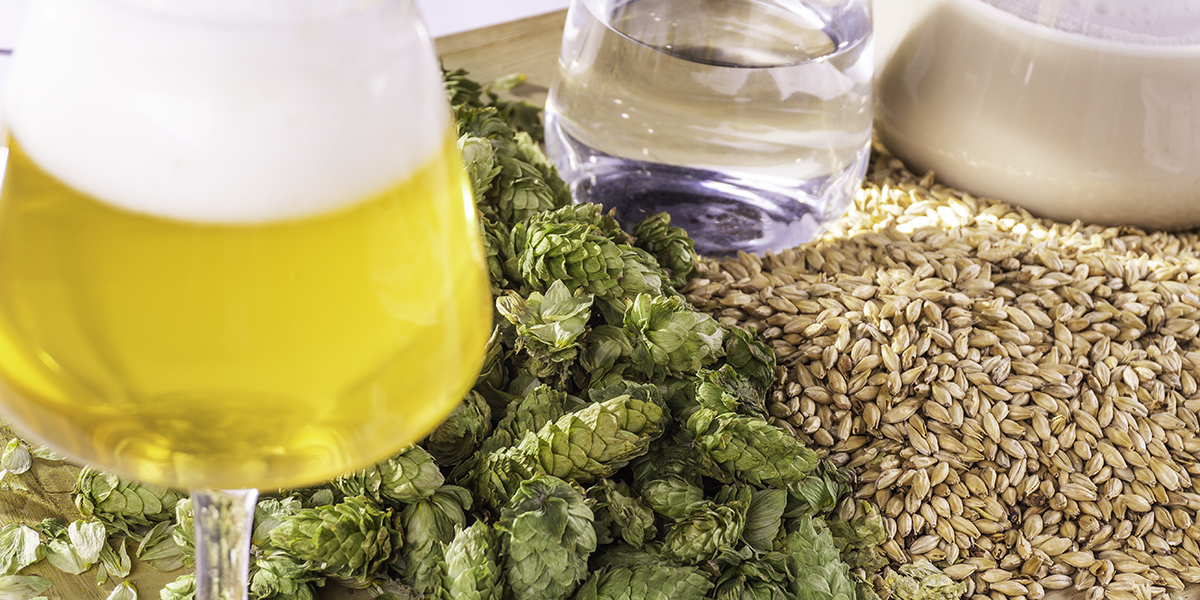The Ingredients that Make Beer
Beer consists of a few core ingredients: water, grain, hops and yeast. Every beer recipe will include some version of each of these four ingredients. It doesn’t matter if the recipe is for homebrewed beer, or a commercially created one… the categories of these ingredients are always the same. Occasionally other additives are used during the brewing process to adjust the beer’s flavor including things like fruit, sugar and spices.
What makes each beer different are the different brewing techniques each brewer follows. Between different amounts of these basic ingredients, timing, and the use of different grains, hops and yeast strains, there are an unimaginable amount of variety possible even within a singular style of beer.
Beer Maverick has compiled the web’s largest online searchable database for hops, grains and yeast for use in beer making. We’ve scoured the internet, publications and research papers to get you the most complete information in order to brew great beer.
Grains
Fermentables such as grains, extracts and various sugars are mashed in approximately 144-170° F water, which creates the wort that ultimately turns into beer with the help of both yeast and hops.
There are two main categories of grains: base and adjunct. Beer recipes consist of a high percentage of base grains such as 2-row barley. Adjuncts are then added to the recipe to add color, flavor and viscosity to the finished beer.
The barley and wheat grains must undergo a malting process before they can be used to make beer (the others do not). The malting process simulates grain germination, which metabolizes the natural grain sugars (called maltose), which is what the yeast feeds on during fermentation. To do so, the seed is soaked in water until the plant starts to grow. Just before it emerges from the seed, it is put in a kiln and dried. The method of drying can make different colors and flavors of malted grain. Malted barley and wheat are commonly referred to as “malts”.
Sometimes grains can be pre-boiled by the grain manufacturers, which then sell the resulting product as a malt extract. Extracts can be sold as either a liquid syrup (LME) or as a dry powder (DME).
Grains give beer three important qualities:
- Malt Flavor and Aroma: These aromas and flavors range from bread-like to chocolatey. These are the two most extreme ends, but there are plenty of other more points in between. Malted grains are a big part of the beer taste.
- Color: This is determined by the type of grain used, and the amount of it. The color can be determined through a few different processes, but SRM is the most accurate and widely used. pale lagers and pale ales are the lightest on the SRM scale, and stouts and porters are some of the darkest.
- Sugar: Grains provide the fermentable material that yeasts consume to create alcohol.
Hops
Hops are used to impart bitterness and aromatic flavors to beer, however certain compounds added by hops also possess antimicrobial properties. The iso-alpha-acids in particular add strong antibacterial qualities against certain strands of bacteria.
A hop’s alpha acid content is what gives beer its bitterness. When hops are boiled, the alpha acid undergoes some chemical changes that allow it to bitter the beer. The less amount of time the hops are boiled, the less hop bitterness is imparted into the beer.
The oils within the hops such as myrcene, humulene, caryophyllene and others are what gives beer their floral, citrusy, hoppy aromas. Different hops have different levels of these oils, resulting in each of them having vastly different flavors.
In historical times, “gruit” or other vegetation were used to add bitterness to beer, but were quickly replaced by hops as it was found that hops simply did a better job at keeping the beer stable and safer over longer periods of time.
All hops are classified as bittering, aroma or dual-purpose varietals, each corresponding to their typical use cases in brewing. In general, bittering hops are added early in the boil, aroma hops are added late in the boil and as a dry hop. Dual-purpose hops can be used at any stage of the beer production process.
Yeast
Yeast eat the fermentable sugars in the water the grains were mashed in and boiled – called wort – and transforms them into alcohol, CO2 and various flavors and aromas called esters. This fermentation process is essential to create the alcohol and flavors we expect from beers. Yeast are very picky as to the type of environment they best work in. They love to have plenty of nutrients, just the right temperature and if they don’t – they get stressed and create off-flavors or simply don’t work.
There are over 100 different strains of beer yeast, and each create their own unique set of flavors, haze levels and alcohol content. Because of these differing qualities, choosing the right type of yeast for your beer style is essential.
There are two major categories of brewing yeast: ale yeast and lager yeast. There are hundreds of different yeast strains within these two categories. Certain strains are suited to making specific beer styles within the ale and lager parent styles.
In short, lager yeast prefer cooler temperatures than ale yeast, creating a cleaner and less flavorful ester profile.
Water
The most oft-forgotten ingredient when making beer is water. Water accounts for over 99% of your beer’s makeup, yet it is often thought about last when brewing beer.
Hops, yeast and grains all make beer what it really is, but the right water profile can take a good beer to fantastic instantly.
Water is often overlooked because it is hard to understand. There are home tests you are expected to have done that will tell you the exact amounts of solubles that are in your default water now. By adding chemicals like gypsum, calcium chloride you can alter your beer’s final tastes and mouthfeels.
In fact, many beer styles are built around the water profile of where that style was originally brewed. This goes for everything from English Ales to New England IPAs.
Beer Styles
All beer styles have their own preferred set of grains, hops and yeast. Based on the particular beer style that is being brewed, certain grains are required to be included into the grist. For example, a hefeweizen needs to have wheat malt to be accurately called a hefeweizen. Wheat beers need to have a significant amount of wheat in the grist. Guidelines are provided for the brewers to ensure their beers conform to the qualities of the specific style.
Some styles like pale ales are very wide open and brewers are allowed to change up the ingredients by quite a lot. For this particular style, it just has to stay under a certain ABV and use an ale yeast.
However, the final beer is only really judged during competitions like the BJCP. There is no law against calling a pale ale an American IPA or vice versa.





